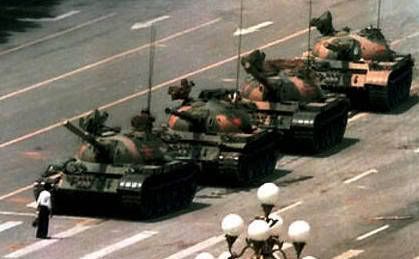Friday, June 04, 2010
In Memoriam: La Bolduc
This Canadian Heritage Moment tells it all, better than I could...
I had never heard of La Bolduc - born on this day in 1894 - until this spot began appearing on Canadian television some years back; I have since downloaded many of her songs and I love them to bits, as much as my Edith Piaf in fact, a singer to whom she's been frequently compared.
So, in the interest of injecting a little regional flavour into the inevitable process of globalization, here is Quebec's Depression-era songbird herself, singing Ça va venir découragez-vous pas, originally recorded in September 1930.
*
share on: facebook
Pop History Moment: Showdown in Tiananmen Square
On this day in 1989 the so-called People's Republic of China crushed a pro-democracy uprising in Tiananmen Square, shooting and killing hundreds of its unarmed people - many of them students - including this lone man who stared down the tanks...

Sources differ as to his identity and his fate, but almost from the moment Jeff Widener's shutter clicked, this iconic hero and his small moment of defiance came to encapsulate not only the entire movement but in a way the futility of that movement as well. Originally known as The Unknown Rebel or less poetically as 'Tank Man', Widener's is just one of the cameras who captured this moment, but seeing as he was then working for the Associated Press, his version has understandably become the most widespread.
*
share on: facebook
Sources differ as to his identity and his fate, but almost from the moment Jeff Widener's shutter clicked, this iconic hero and his small moment of defiance came to encapsulate not only the entire movement but in a way the futility of that movement as well. Originally known as The Unknown Rebel or less poetically as 'Tank Man', Widener's is just one of the cameras who captured this moment, but seeing as he was then working for the Associated Press, his version has understandably become the most widespread.
*
share on: facebook
POPnews - June 4th
[Although the maiden voyage of the montgolfière was unmanned - unlike the one in this image - by November 1783 les frères Montgolfier Joseph-Michel and Jacques-Etienne managed to launch a young physician, Jean-François Pilâtre de Rozier, and an audacious army officer, François Laurent d'Arlandes skyward; both of these flights, fortunately, went better than their initial test flight in December 1782, during which the balloon drifted for more than 2 km before crashing.]
1760 - Following the Great Upheaval planters from New England arrived in Nova Scotia to claim land taken from the Acadians.
1783 - The Montgolfier Brothers publicly demonstrated their montgolfière, an early version of the hot air balloon.
1792 - Captain George Vancouver claimed Puget Sound for Great Britain.
1804 - Grieving over the death of his wife, Marie Clotilde, Sardinia's King Charles Emmanuel IV abdicated in favor of his brother, Victor Emmanuel.
1876 - An express train called the Transcontinental Express arrived in San Francisco via the First Transcontinental Railroad only 83 hours and 39 minutes after leaving New York City.
1917 - The very first Pulitzer Prizes were awarded, to Laura E. Richards, Maude H. Elliott, and Florence Hall for their biography of Julia Ward Howe, to historian Jean Jules Jusserand for his book With Americans of Past and Present Days, and to Herbert B. Swope for his work as a journalist with the New York World.
1919 - The US Congress approved the 19th Amendment to the US Constitution - which would guarantee American women the right to vote - and sent it to the individual states for ratification.
1928 - Zhang Zuolin, President of the Republic of China, was assassinated by Japanese agents when a bomb planted along the South Manchuria Railway by Fujii Sadatoshi of the Guandong Army exploded, destroying the president's rail car, during the so-called Huanggutun Incident.
1939 - The SS St. Louis - a ship carrying 963 Jewish refugees - was denied permission to land in Florida after already having been turned away from Cuba; forced to return to Europe, many of its passengers later died in Nazi concentration camps. The story was told in the 1976 film Voyage of the Damned, starring Faye Dunaway.
1940 - The Dunkirk Evacuation ended when British forces completed the evacuation of 300,000 troops from the French port of Dunkirk, as dramatized in the 1942 film Mrs. Miniver, as well as both Ian McEwan's novel Atonement and the 2007 film adaptation of the same name.
1942 - Reichssicherheitshauptamt Reinhard Heydrich died of his injuries in Prague following an assassination attempt by Czechoslovak paratroopers Jan Kubiš and Jozef Gabčík during Operation Anthropoid, which was carried out on May 27th.
1943 - A military coup in Argentina ousted Ramón Castillo during that country's Década Infame.
1970 - Tonga gained its independence from the United Kingdom.
1979 - Flight Lieutenant Jerry Rawlings took power in Ghana during military coup in which General Fred Akuffo was overthrown.
1986 - Jonathan Pollard pleaded guilty to espionage for selling top secret US military intelligence to Israel.
1989 - Pro-democracy protests in Beijing's Tiananmen Square ended violently ended when soldiers and tanks of the People's Liberation Army invaded the square, killing many innocent people.
1998 - Terry Nichols was sentenced to life in prison for his role in the Oklahoma City bombing.
*
share on: facebook
Subscribe to:
Posts (Atom)


